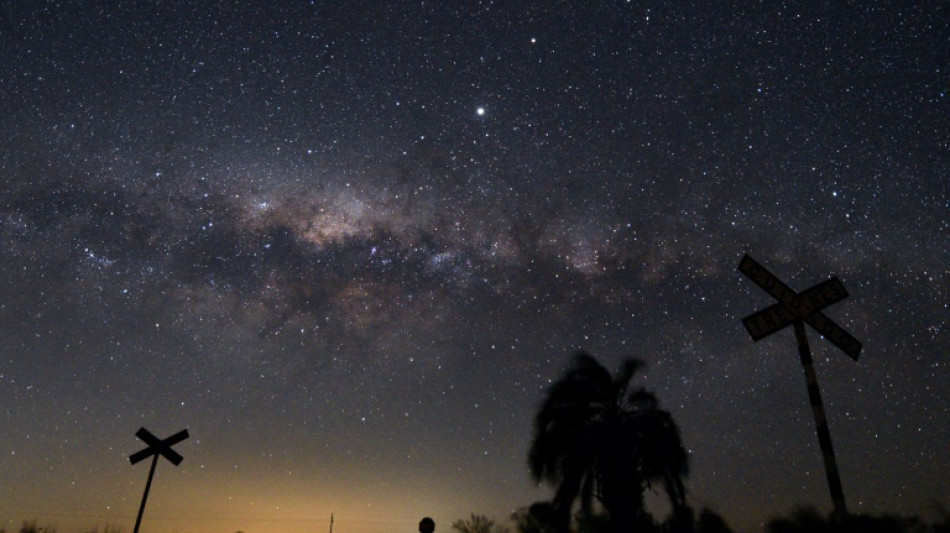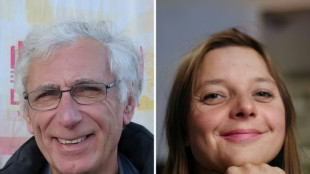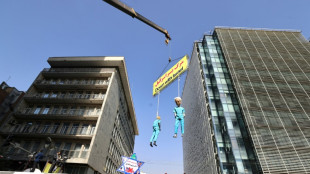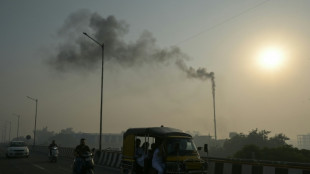
-
 Where things stand on China-US trade after Trump and Xi talk
Where things stand on China-US trade after Trump and Xi talk
-
Sri Lanka targets big fish in anti-corruption push

-
 NY elects leftist mayor on big election night for Democrats
NY elects leftist mayor on big election night for Democrats
-
Injured Jordie Barrett to miss rest of All Blacks tour

-
 Asian markets tumble as tech bubble fears grow
Asian markets tumble as tech bubble fears grow
-
Pay to protect: Brazil pitches new forest fund at COP30

-
 Australia pick 'impressive' Weatherald in first Ashes Test squad
Australia pick 'impressive' Weatherald in first Ashes Test squad
-
Iraq's social media mercenaries dying for Russia

-
 Young leftist Trump foe elected New York mayor
Young leftist Trump foe elected New York mayor
-
Concerns at ILO over expected appointment of close Trump advisor

-
 Venus Williams to return to Auckland Classic at the age of 45
Venus Williams to return to Auckland Classic at the age of 45
-
No deal yet on EU climate targets as COP30 looms

-
 Typhoon death toll climbs to 66 in the Philippines
Typhoon death toll climbs to 66 in the Philippines
-
NATO tests war preparedness on eastern flank facing Russia

-
 Uncapped opener Weatherald in Australia squad for first Ashes Test
Uncapped opener Weatherald in Australia squad for first Ashes Test
-
Liverpool down Real Madrid in Champions League, Bayern edge PSG

-
 Van Dijk tells Liverpool to keep calm and follow Arsenal's lead
Van Dijk tells Liverpool to keep calm and follow Arsenal's lead
-
PSG left to sweat on injuries to Dembele and Hakimi

-
 Reddit, Kick to be included in Australia's social media ban
Reddit, Kick to be included in Australia's social media ban
-
Ex-Zimbabwe cricket captain Williams treated for 'drug addiction'

-
 Padres ace Darvish to miss 2026 MLB season after surgery
Padres ace Darvish to miss 2026 MLB season after surgery
-
Diaz hero and villain as Bayern beat PSG in Champions League showdown

-
 Liverpool master Real Madrid on Alexander-Arnold's return
Liverpool master Real Madrid on Alexander-Arnold's return
-
Van de Ven back in favour as stunning strike fuels Spurs rout

-
 Juve held by Sporting Lisbon in stalling Champions League campaign
Juve held by Sporting Lisbon in stalling Champions League campaign
-
New lawsuit alleges Spotify allows streaming fraud

-
 Stocks mostly drop as tech rally fades
Stocks mostly drop as tech rally fades
-
LIV Golf switching to 72-hole format in 2026: official

-
 'At home' Djokovic makes winning return in Athens
'At home' Djokovic makes winning return in Athens
-
Manchester City have become 'more beatable', says Dortmund's Gross

-
 Merino brace sends Arsenal past Slavia in Champions League
Merino brace sends Arsenal past Slavia in Champions League
-
Djokovic makes winning return in Athens

-
 Napoli and Eintracht Frankfurt in Champions League stalemate
Napoli and Eintracht Frankfurt in Champions League stalemate
-
Arsenal's Dowman becomes youngest-ever Champions League player

-
 Cheney shaped US like no other VP. Until he didn't.
Cheney shaped US like no other VP. Until he didn't.
-
Pakistan edge South Africa in tense ODI finish in Faisalabad

-
 Brazil's Lula urges less talk, more action at COP30 climate meet
Brazil's Lula urges less talk, more action at COP30 climate meet
-
Barca's Lewandowski says his season starting now after injury struggles

-
 Burn urges Newcastle to show their ugly side in Bilbao clash
Burn urges Newcastle to show their ugly side in Bilbao clash
-
French pair released after 3-year Iran jail ordeal

-
 EU scrambles to seal climate targets before COP30
EU scrambles to seal climate targets before COP30
-
Getty Images largely loses lawsuit against UK AI firm

-
 Cement maker Lafarge on trial in France over jihadist funding
Cement maker Lafarge on trial in France over jihadist funding
-
Sculpture of Trump strapped to a cross displayed in Switzerland

-
 Pakistan's Rauf and Indian skipper Yadav punished over Asia Cup behaviour
Pakistan's Rauf and Indian skipper Yadav punished over Asia Cup behaviour
-
Libbok welcomes 'healthy' Springboks fly-half competition

-
 Reeling from earthquakes, Afghans fear coming winter
Reeling from earthquakes, Afghans fear coming winter
-
Ronaldo reveals emotional retirement will come 'soon'

-
 Munich's surfers stunned after famed river wave vanishes
Munich's surfers stunned after famed river wave vanishes
-
Iran commemorates storming of US embassy with missile replicas, fake coffins


Star visibility eroding rapidly as night sky gets brighter: study
Light pollution is growing rapidly and in some places the number of stars visible to the naked eye in the night sky is being reduced by more than half in less than 20 years, according to a study released Thursday.
The researchers, whose findings were published in the journal Science, said the increase in light pollution -- skyglow -- that they found was much larger than that measured by satellite observations of Earth at night.
For the study of the change in global sky brightness from artificial light, the researchers used stellar observations from 2011 to 2022 submitted by more than 51,000 "citizen scientists" around the world.
Participants in the "Globe at Night" project run by the US National Optical-Infrared Astronomy Research Laboratory were given star maps and asked to compare them to the night sky at their location.
The change in the number of visible stars reported was equivalent to a 9.6 percent per year annual increase in sky brightness, averaged over the locations of the participants, the researchers said.
Over an 18-year period, given such star brightness change, a location with 250 visible stars would see that number reduced to 100.
Most of the naked-eye star observations came from Europe and the United States said Christopher Kyba, one of the authors of the study, but there was also good participation in Uruguay, South Africa and Japan.
"The global trend in skyglow that we measure likely underestimates the trend in countries with the most rapid increases in economic development, because the rate of change in light emission is highest there," the researchers said.
The study coincided with the replacement of many outdoor lights with light-emitting diodes (LEDs), but the researchers said the impact on skyglow from the transition to LEDs is unclear.
"Some researchers have predicted that it will be beneficial; others, that it could be harmful because of spectral changes or a rebound effect, in which the high luminous efficacy of LEDs leads to more or brighter lights being installed or longer hours of operation," they said.
According to the study, the global LED market share for new general lighting grew from under one percent in 2011 to 47 percent in 2019.
"The visibility of stars is deteriorating rapidly, despite (or perhaps because of) the introduction of LEDs in outdoor lighting applications," the researchers said.
"Existing lighting policies are not preventing increases in skyglow, at least on continental and global scales."
- 'Confronted with the cosmos' -
Kyba, a physicist at the German Research Center for Geoscience, told AFP that while the team was able to evaluate erosion of star visibility due to skyglow, not a lot of research has been done on its ecological impact.
"There's tons of research on light shining directly on animals and plants," he said. "But it's really hard to do experiments on the impact of skyglow.
"You're not going to do something like just turn off New York City and see what happens in the East River."
Science aside, light pollution has changed the character of the night sky.
"For all of human history, when people went outside at nighttime, they were sort of confronted with the cosmos, at least on clear nights with no moon," Kyba said.
"You'd walk outside and there's the stars, there's the Milky Way. It's there and it's shining down on you," he said.
"And now that's like a really unusual experience," he said. "It surely makes a difference to us as people that we don't have this experience that used to be a very universal experience."
The Globe at Night campaign hosts an interactive data map at globeatnight.org and is seeking volunteers to collect more observations in 2023.
R.Shaban--SF-PST


